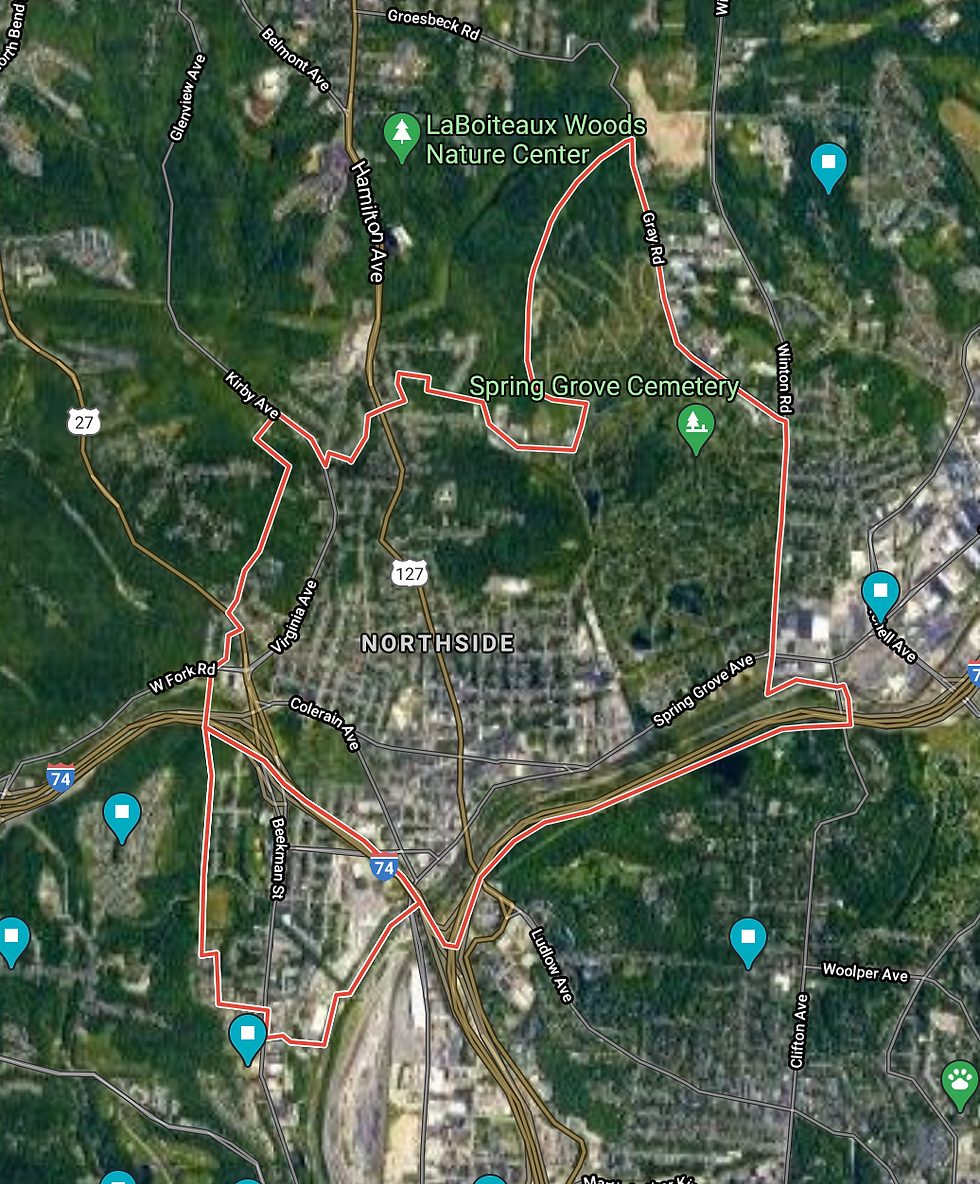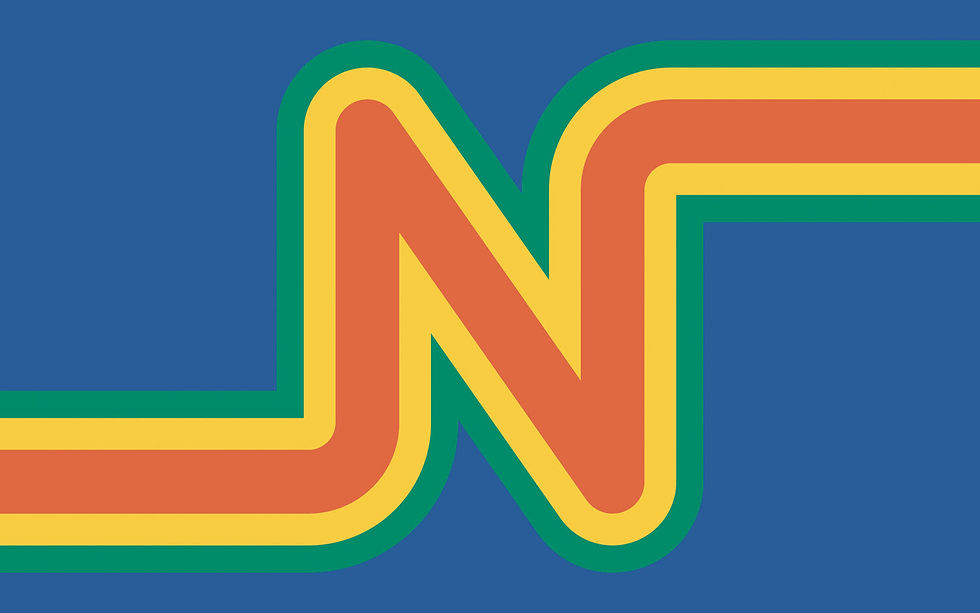South Cumminsville and Northside: Cumminsville, divided.
- Anthony Gustely

- Oct 25, 2020
- 5 min read

Aaaaaand we're back! Apologies on not uploading last week, my roomies and I had a bit of a COVID-related scare this past week. We all wanted to make sure we tested negative and followed the State of Ohio guidelines for staying inside and away from others! Since this week was a sort of return-to-form for my roommates and I, they decided to tag along this week to South Cumminsville and Northside. Nicole, Ryan, Hannah, and I ventured towards the two neighborhoods this past Sunday.
Remember at the beginning of this project when I explained that the construction of the highways transformed many of Cincinnati's neighborhoods, mostly negatively? South Cumminsville and Northside are a prime example of a once united community that was split down the center. Let's get into it.
History
Unsurprisingly (given Cincinnati's rich history with immigrant beginnings), the area of Cumminsville (which includes both South Cumminsville and Northside) was founded by German Catholic immigrants and annexed into the city in 1873. Cumminsville had a thriving commercial corridor, known as Knowlton's Center. Growing to one of the larger commercial nodes within the city well into the 1920s, the 1940s brought drastic change to the community.
Cumminsville experienced a dramatic boom in industry to support the ongoing second World War. Post-war, this transition from residential land uses to industrial land uses was coupled with an expanding automobile and housing industry. During this time, Interstate-74 was constructed to connect new housing developments outside of the city to the jobs closer to downtown Cincinnati. South Cumminsville, which had become a sub-neighborhood for African American residents since the early 1900s, was effectively cut off from the "North Side". Interestingly, although Northside reaped the benefits of the existing commercial corridor within its bounds, both neighborhoods experienced a decline in industry In the 1960s.
It would take Northside another two decades to rebound and begin reinvestment into their downtown core. On the flip side, South Cumminsville remained primarily a residential community. With a smaller land area, South Cumminsville lacked a robust tax base that comes with increased commercial and industrial land use. The neighborhood was both isolated and dominated by a large I-74 interchange that now caps the northern boundary of the community.

South Cumminsville
Starting with the neighborhood closest to us, my friends and I took a drive around South Cumminsville to begin our day. We were so bummed that we were just one week too late to experience some of the local cuisine. Opened over 58 years ago, Mr. Gene's Dog House is a community staple in South Cumminsville, serving up classic American fare. With over 750 google reviews, I will most definitely be back to eat at this iconic restaurant. Mr. Gene's is open February 15 to October 15 yearly. Support local business!

Next up on our stop was another neighborhood landmark: St. Pius Place. Now a retirement community, the historic church is beautiful from the outside. One prominent feature of South Cumminsville my friends and I noticed on our drive around the neighborhood was the overwhelming amount of churches. It's clear that the plethora of churches serve as a reminder of Cumminsville's German Catholic beginnings.

There are several community organizations leading the charge in South Cumminsville to advocate for and improve community life. Working In Neighborhoods (WIN) is a community nonprofit headquartered within South Cumminsville. The organization focuses on community building, home ownership, and economic learning for low and moderate income neighborhoods within Cincinnati. I encourage you to read this article on WIN's website to learn about the success they've fostered within South Cumminsville. Additionally, this video made by WCPO in 2017 features community members' experiences in South Cumminsville.
Northside
As previously mentioned, the "North Side" of Cumminsville was originally a way for white, middle to high income residents to segregate themselves from the South Cumminsville, a sub-neighborhood where primarily African American residents settled. Despite is overtly racist beginnings, Northside has actually evolved to be known as one of (if not THE) most progressive and liberal neighborhood in Cincinnati. Now socioeconomically diverse and a well-known LGBTQIA+ friendly community, Northside thrives through its bustling local business corridor along US-127 (aka Ludlow Ave).
While some neighborhoods in Cincinnati have less to offer, it was a struggle for me to pin down just a few of the many different staples in Northside. For an early dinner, the roomies and I decided on the iconic Tickle Pickle. Serving up burgers named after rockstars and a great selection of beer, I was actually introduced to Tickle Pickle a few years ago by my good friend, Braden. The food is ALWAYS amazing. Two of my favorites include the Mariah Curry (a curried chicken sandwich) and the Nom Petty (burger w/ goat cheese and jalapeno jam), but I tried something new and ordered the Rob Zomwich (burger w/ a jalapeno popper, peppers and onions, and spicy ketchup). It was amazing! I also tried a seasonal canned cider that they offered (pictured below) and it was also great. All of my friends loved their meals as well, and we even got say hi to Ryan's friend, Ellie, who was working! I can't say enough about how delicious Tickle Pickle is, you'll have to try it for yourself sometime!



After dinner, we decided to digest our food a bit and take a walk to explore around the business district. We were mesmerized at the variation in housing stock around Northside, which included mixed-use apartments above storefronts, new housing developments, brightly colored older housing, and an infill project. Urban infill refers to the redevelopment of underused land in existing urban areas. Quite literally, urban infill in regards to housing means creating homes that "fill in" the gaps of empty or unused land in a neighborhood. One of these projects within Northside was the conversion of the former American Can Factory into the American Can Lofts. This project is incredibly interesting and comes with a slew of amenities. It also includes several "green" features, including the fact that the building is "recycled" for another use.



To cap the evening, the roomies and I ventured away from the business district over to Dojo Gelato. Situated in an interestingly-shaped triangular parcel at the intersection of Blue Rock Street and Colerain Avenue, Dojo Gelato offers a unique and wide selection of flavors. They also have a large patio with tables and chairs to eat at after you order! I ordered one scoop of gooey butter cake gelato and one scoop of passionfruit gelato. Both were heavenly, and the roomies also enjoyed their scoops.


After reflecting on my visits to both neighborhoods, I thought long an hard about the impact of I-74 and it's impact on Cumminsville. Growing up, highways were mentioned briefly in American history as expanding the country's road network, symbols of the Baby Boom that revolutionized modern auto travel. It is not coincidental that the widespread horrors of displacement, demolition, and poverty caused by the construction of the American Highway System are not talked about. It is no accident that these horrors disproportionately affected African American communities (low income and minority communities were the first to go when developers needed space for highways to connect through urban areas).
It's important to remember that the anecdotal story of the division of South Cumminsville and Northside is not local. While there are many more stories within Cincinnati of neighborhood displacement, there also many more stories in many more American cities of displacement. South Cumminsville, although negatively affected by I-74, is a united community that continues to rebuild and strengthen itself. Perhaps the resurgence of Northside proves that small business districts closer to the urban core can compete and thrive despite increased auto dependency and rapid through-travel that cuts through communities (I-74).

Thanks for reading! See you next week :)






Comments